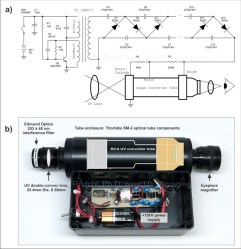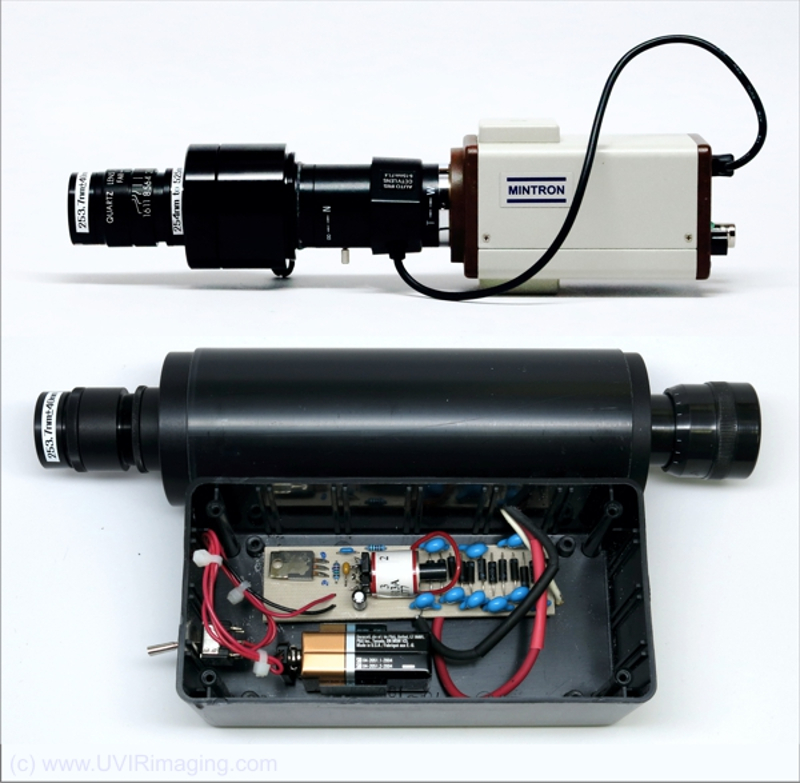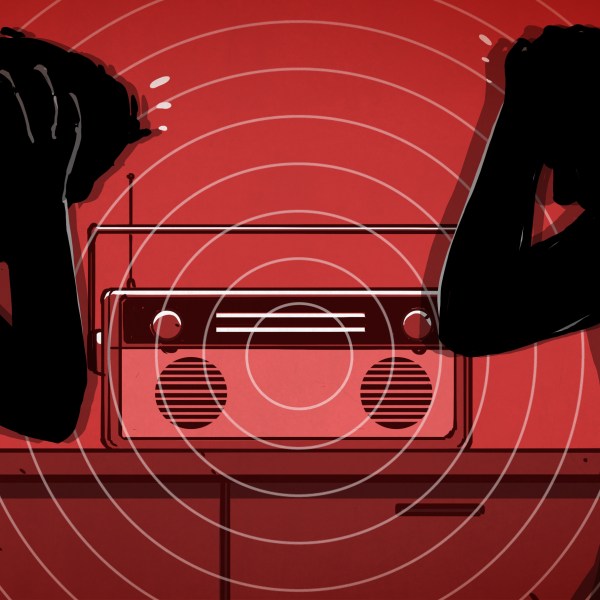We’ve all seen how to peel IR filters off digital cameras so they can see a little better in the dark, but there’s so much more to this next project than that. How about being able to see things normally completely outside the visual spectrum, like hydrogen combustion or electrical discharges?

[David Prutchi] has just shared his incredible work on making his own shortwave ultraviolet viewers for imaging entirely outside of the normal visible spectrum – in other words, seeing the truly invisible. The project has not only fascinating application examples, but provides detailed information about how to build two different imagers – complete with exact part numbers and sources.
 If you’re thinking UV is a broad brush, you’re right. [David Prutchi] says he is most interested in Solar Blind UV (SBUV):
If you’re thinking UV is a broad brush, you’re right. [David Prutchi] says he is most interested in Solar Blind UV (SBUV):
Solar radiation in the 240 nm to 280 nm range is completely absorbed by the ozone in the atmosphere and cannot reach Earth’s surface…
Without interference from background light, even very weak levels of UV are detectable. This allows ultraviolet-emitting phenomena (e.g. electrical discharges, hydrogen combustion, etc.) to be detectable in full daylight.
There is more to the process than simply slapping a UV filter onto a camera, but happily he addresses all the details and the information is also available as a PDF whitepaper. [David Prutchi] has been working with imaging for a long time, and with his sharing of detailed build plans and exact part numbers maybe others will get in on the fun. He’s also previously shared full build plans for a Raspberry Pi based multispectral imager, [David’s] DOLPHi Polarization Camera was a finalist in the 2015 Hackaday Prize, and he spoke at the Hackaday SuperConference about the usefulness of advanced imaging techniques for things like tissue analysis in medical procedures, and landmine detection for the purposes of cleaning up hazardous areas.
















Geordi Laforge endorses this product.
ROTFL!
Great project [David Prutchi]!
240 nm to 280 nm (UVC) shreds DNA, so for safety purposes alone it would be good to be able to see this remotely.
100-280 nm is UVC and used to disinfect.
the subtle smell of ozone around germicidal lamps suggests light at these wavelengths experiences significant attenuation so the range will be limited.
AFACS all he did was buy a purpose-made image conversion tube from ebay. Mentions that new ones are available but no indiciation of cost ( nothing obvious on the findrscope site he linked to)
Nope, they made their own UV to visible light converter screens – “I made dilute suspensions of these three powders in acetone (hardware store, from the paint thinner aisle) and just a tiny bit of Beacon 527 multi-use glue (from crafts store). To make a converter screen, I applied one drop of suspension at a time to a spinning 1” diameter glass blank and let it evaporate very evenly. I used a filtered shortwave UV lamp to gauge the thickness and evenness of the coating after each drop.”
He does mention making his own converters, but all of the images on his site are from commercial cameras… Does not bode well for the utility of such DIY systems.
I’m sure if Ben Krasnow decided to make a few they would be nice :)
Did anyone try to use Compton scattering for this? If we had a sandwich of two plates of glass (e.g microscope samples glass plates) pressed against each other so that there was very little air in between, and if there was a thin metallic layer on one of the inner surfaces (e.g. semitransparent or common mirror without protective paint from its back), then when light of sufficiently short wavelength would pass through the glass and hit the atoms of the metal, the atoms would emit electrons (photoelectric effect) into the mostly empty space between glass plates.
Subsequent photons of light hitting those free electrons would scatter and by doing so they would lower their wavelength, hopefully becoming detectable by ordinary commonly available light detectors (maybe even our eyes?)
Greetings, you just invented what is called image intensifier, which is in use since… wait for it… 1939. It is the device used in analogue night vision. These have been made usually for IR vision, but there were also visible light devices. Even X-ray image intensifiers were made for healthcare purposes. And yes, MCPs can be “almost flat”.
MCPs are secondary electron devices similar to photomultipliers. For IR Vision you do not want frequency/energy down conversion as the energy is already too low to be visible. So the Compton scattering device seems to be something different, though “salec” probably did not invent it and it is already known for some time.
I guess 300nm to 390nm or 700nm to 1000nm is part of the visible spectrum and we’re just not trying hard enough?
Dammit. Did I get comment-baited again?
it gets really blurry and hard beyond 380nm. On the other hand you can see diffuse spots of a Ti:Sa laser well beyond 820-850nm if it is powerful enough. Human vision would only extend beyond that if you chose to swap some carotenoids in your diet (A2, not recommended).
A laser engineer said, vision extends up to 900 nm, it is just a question of intensity.
808nm (Nd:YAG (DPSS) pump radiation can also be seen in daylight. But you should be careful, not to see too much of it. :-)
850nm (IR illumination LEDs on surveillance cameras, IR headphone transmitter) is visible to the dark adapted eye as a deep red glow.
900 to 1000nm? I don’t know, probably the margin between sensitivity and (laser) burn threshold is too small to try.
We use these at work. They are night vision scopes with different UV filters to attach so we can see corona without having to turn out all the lights. And they are in fact just that. Off the shelf night vision scopes with filter mounts and a few different bandpass filters. But you can buy more advanced ones for $100,000 and up if you need to attach them to your helicopter for transmission line arcing, if that’s your game.
He didn’t invent something new, I think he’s just trying to make the tech accessible to regular joes without a huge budget for such gadgetry.
Now that site is an example of an excellent write-up and how it should be done (if you are a person who can).
So often such a thing is done poorly, often because people just dont’ have the mind to convey information in a clear and simple manner while retaining the information.
Hi!
Thanks Whatnot for your kind words about my blog. I try to pass along what I learn about a topic so that fellow hackers can build upon it instead of “reinventing the wheel.”
Thanks When did writer = engineer? for your explanation. Indeed, it is the performance of those $$$$ cameras that motivated me to try to experiment in the shortwave UV using affordable components.
I have been experimenting with evaporating thin films of organic and inorganic phosphors directly onto camera sensors to expand their range below 300 nm. I’ll be reporting at Hackaday once I set up an apples-to-apples comparison of my diy-coated sensors.
Cheers,
David
http://www.UVIRimaging.com
http://www.diyPhysics.com
You’re awesome!